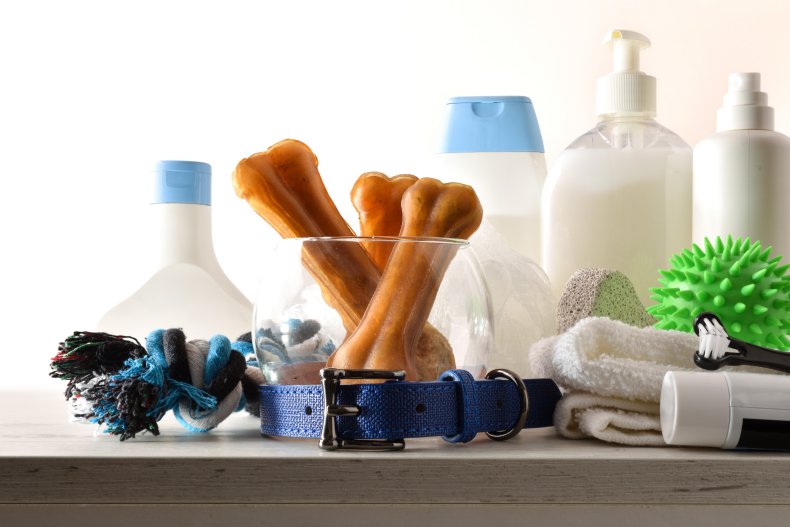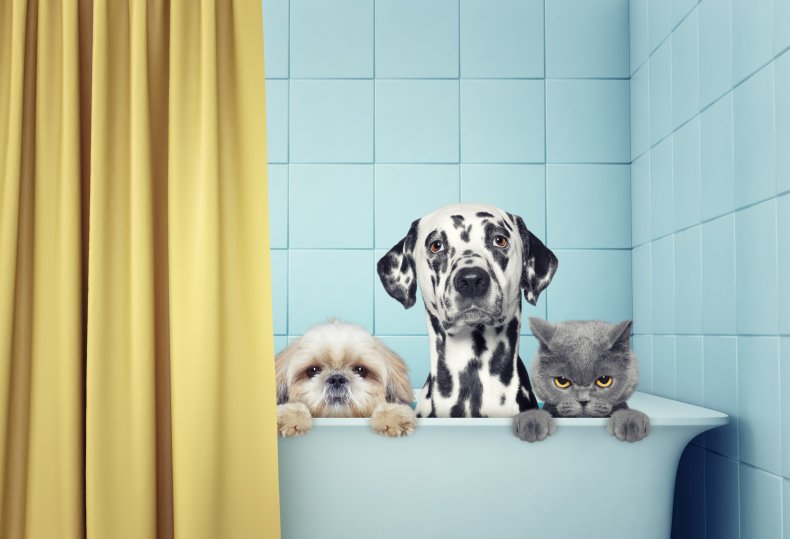Moisturizing is a daily ritual for most of us, but do our pets need a similar kind of care to keep their skin healthy?
Newsweek spoke to veterinarians to find out whether or not you should moisturize your pet and, if so, what the best products are.
Like humans, our pets can get dry and chapped skin. This is a fairly common condition among pets and can result in dandruff, hair loss, and flaky skin that may cover the entire body. Possible causes may be allergies, hormonal conditions or even seasonal changes, such as air conditioning in the summer and heating in the winter.
Having a healthy skin layer helps to keep out bacteria and viruses, veterinarian Carling Matejka told Newsweek. It also helps to maintain hydration by increasing water absorption and decreasing evaporation. That’s why it’s important to learn how to keep your pet moisturized.
But, Hunter Finn, a Texas-based integrative veterinarian, said there is no reason to moisturize your pet unless it has a specific skin condition such as atopic dermatitis that requires it or if you give your pet frequent baths. And even in that case, many hypoallergenic shampoos for pets will already contain moisturizers, he told Newsweek.
Getty Images
Why Does My Dog Have Dry Skin?
Many agents can cause your pet to suffer from dry, flaky, or itchy skin. The best treatment for your pet can change, depending on the reason for its condition.
1. It could be their diet
An imbalance of essential fatty acids (omega-3 and omega-6) and a lack of protein are two diet-related factors that can cause the pet’s skin to become itchy and flaky. Or it could be some ingredients in its food. In that case, you should speak to your vet about a diet change.
2. You may be bathing them too much
Active pets that are prone to getting dirty or larger dogs with long hair need bathing more frequently than thin-haired breeds and those that spend most of their time indoors. But keep bathing to a once-a-month affair because over-bathing your pet is likely to strip the skin of its natural oils, leading it to become dry and flaky.
3. Environmental causes
Another cause of dry skin may be dry air, so if you live in an area where the humidity tends to be low, get a humidifier to help add moisture back into the air.
4. Allergies and health issues
Dry skin could also be due to allergies, whether food allergies or seasonal ones. Or there may be other health issues, including bacterial and fungal infections such as ringworm. Moreover, if your dog has a metabolic disease, such as hypothyroidism or an autoimmune illness, you may find dry skin is a common side effect.
What Products Are Best for Moisturizing Your Pet?
1. Omega-3, Omega-6 fatty acids
Matejka said using products formulated for your pets will ensure that your pet’s skin is getting the nutrients it needs because they have gone through testing to ensure it is safe, healthy and helpful.
She said: “No matter which product you use, ensure that it is [Association of American Feed Control Officials] certified. Be cautious that nutritional deficiencies aren’t the cause of unhealthy skin. To help combat dry skin, oral supplements rich in omega 3 and 6 fatty acids can do wonders for the skin and hair.”
Speak to your vet before giving your pet supplements.

Getty Images
2. Hypoallergenic shampoo
Using a hypoallergenic shampoo is best to avoid the extra step of moisturizing after the bath, as it eliminates unnecessary steps on your end. You can also apply conditioner afterward to help with any skin irritation and allergies. If you do, apply the moisturizer within two minutes of the bath, while the pet is still damp.
Veterinarian Lauren Witter of Small Door Veterinary in New York City told Newsweek that healthy dogs and cats have oil glands that work to keep the skin and coat properly moist. But hairless animals may need some help with the overproduction of oil or dry skin, in which case vets may suggest omega-3 supplementation.
“Depending on the skin condition, the vet may also prescribe medicated shampoos specific to the pet’s skin needs as well,” Witter said.
3. Petroleum jelly on their paws
Another area where your pet could experience dryness and cracking is the paw pads, thanks to salted streets and snow and ice in the winter. Witter said that’s when barrier protection, such as applying petroleum jelly, having your pet wear booties or using a paw balm, is recommended.
She also said it’s very important that anything that is applied to an animal’s skin needs to be OK for it to eat. So always ask your veterinarian about this before using any type of product on your pet.

Getty Images
Natural Ways to Keep Your Pet Moisturized
There are a few ways to keep your pet’s skin healthy and free from dryness and flaking regardless of the cause of their condition.
1. Make sure they have a healthy diet
The best way to keep your pet healthy is a good diet that is complete and balanced.
2. Make sure your pet is drinking enough water
Water is essential for keeping the body functioning at its best and also essential to adding moisture to the skin. Normal water intake for a pet is defined as 1 to 2 milliliters per kilogram of body weight per hour, which is equivalent to approximately 25 to 50 ml/kg in 24 hours. For example, a 10-kilogram dog would be expected to drink approximately 480 ml in 24 hours.
3. Regular grooming
For your dog, regular grooming sessions are the easiest way to keep fur and skin healthy, using a specific dog brush. Brush your pup at least once a week.
4. Do Not Use Human Skin Care Products
Dogs and cats need products that are specifically formulated for them, so stay away from using products you use yourself. Using pet-friendly shampoos is necessary to avoid damaging your pet’s skin and causing discomfort or disease.
Matejka said pets have a different pH level compared with people, so using human products can disrupt the renewal of their skin’s protective barrier and lead to skin problems. Pet shampoo, conditioners and skin moisturizers help maintain a pH level appropriate for our pets. Human products can also contain chemicals that are toxic to pets if they groom themselves after a bath.
Moreover, she warned that ingestion of products not made for pets may cause drooling, vomiting or diarrhea. It can also cause skin problems like bacterial or yeast skin infections to worsen.
Do you have funny and adorable videos or pictures of your pet you want to share? We want to see the best ones! Send them in to [email protected] and they could appear on our site.


